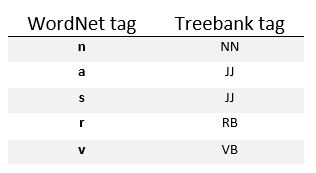自然语言处理 |用于标记的 WordNet
WordNet 是词汇数据库,即英语词典,专为自然语言处理而设计。

代码 #1:创建类以在 WordNet 中查找单词。
from nltk.tag import SequentialBackoffTagger
from nltk.corpus import wordnet
from nltk.probability import FreqDist
class WordNetTagger(SequentialBackoffTagger):
'''
>>> wt = WordNetTagger()
>>> wt.tag(['food', 'is', 'great'])
[('food', 'NN'), ('is', 'VB'), ('great', 'JJ')]
'''
def __init__(self, *args, **kwargs):
SequentialBackoffTagger.__init__(self, *args, **kwargs)
self.wordnet_tag_map = {
'n': 'NN',
's': 'JJ',
'a': 'JJ',
'r': 'RB',
'v': 'VB'
}
def choose_tag(self, tokens, index, history):
word = tokens[index]
fd = FreqDist()
for synset in wordnet.synsets(word):
fd[synset.pos()] += 1
return self.wordnet_tag_map.get(fd.max())
这个 WordNetTagger 类将计数。在 Synsets 中找到一个词的每个 POS 标签,然后,最常见的标签是使用内部映射的树库标签。
代码 #2:使用简单的 WordNetTagger()
from taggers import WordNetTagger
from nltk.corpus import treebank
# Initializing
default_tag = DefaultTagger('NN')
# initializing training and testing set
train_data = treebank.tagged_sents()[:3000]
test_data = treebank.tagged_sents()[3000:]
wn_tagging = WordNetTagger()
a = wn_tagger.evaluate(test_data)
print ("Accuracy of WordNetTagger : ", a)
输出 :
Accuracy of WordNetTagger : 0.17914876598160262
使用 Code 3,我们可以提高准确性。
代码 #3:NgramTagger 退避链末端的 WordNetTagger 类
from taggers import WordNetTagger
from nltk.corpus import treebank
from tag_util import backoff_tagger
from nltk.tag import UnigramTagger, BigramTagger, TrigramTagger
# Initializing
default_tag = DefaultTagger('NN')
# initializing training and testing set
train_data = treebank.tagged_sents()[:3000]
test_data = treebank.tagged_sents()[3000:]
tagger = backoff_tagger(train_data,
[UnigramTagger, BigramTagger,
TrigramTagger], backoff = wn_tagger)
a = tagger.evaluate(test_data)
print ("Accuracy : ", a)
输出 :
Accuracy : 0.8848262464925534